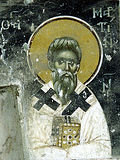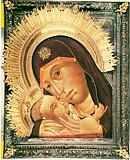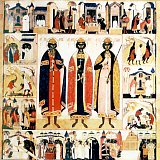

| Previous day | Next day |
| Old Style
April 14
|
Wednesday |
New Style
April 27
|
| Bright Week. Fast-free period. | No fast.
|
![]() St. Martin the Confessor, pope of Rome (655).
St. Martin the Confessor, pope of Rome (655).
Martyrs Anthony, John, and Eustathius, of Vilnius, Lithuania (1347). Martyr Ardalion the Actor, who suffered under Maximian (4th c.). Martyr Azat the Eunuch and 1,000 Martyrs, in Persia (341). Synaxis of the Holy Fathers of Mt. Sinai.
New Martyr Sergius (Trofimov) of Nizhni-Novgorod and companion (1918).
Vilna Icon of the Most Holy Theotokos. “Kasperov” Icon of the Most Holy Theotokos (16th c.).
St. Tassach, bishop of Raholp (Ireland) (5th c.). Monk-martyr Christopher of St. Sabbas’ Monastery (797). New Martyr Demetrius of the Peloponnese, at Tripolis (1803). Apostles Aristarchus, Pudens, and Trophimus, of the Seventy (ca. 67). St. Cyriacus, chorepiscopus of Jerusalem, and his mother, Martyr Anna (363).
Thoughts for Each Day of the Year
According to the Daily Church Readings from the Word of God
By St. Theophan the Recluse

Wednesday. [Acts 2:22–36; John 1:35–51]
The mind can prove the truth of the Resurrection through reason based on the scriptures, and a non-believer cannot but admit the power of its arguments, as long as a sense of truth is not yet dead in him. A believer does not need proof, because the Church of God is filled with the light of the Resurrection. Both of these indicators of truth are faithful and convincing. But counter-reasoning can spring up and contradict mind’s reason, and faith can be trampled and shaken by perplexities and doubts, coming from without and arising within. Is there no invincible wall around the truth of the Resurrection? There is. It will occur when the power of the Resurrection, received already at baptism, begins to actively be revealed as it purges the corruption of soul and body, and establishes within them the beginnings of a new life. He who experiences this will walk in the light of the Resurrection, and anyone talking against the truth of the Resurrection will seem to him insane, like a person saying in the daytime that it is night.
Articles
 Martyrs Anthony, John, and Eustathius, of Vilnius, LithuaniaThe Holy Martyrs Anthony, John, and Eustathius were brothers who suffered for Christ under the Lithuanian Great Prince Olgerd (1345-1377). |
 Martyr Ardalion the ActorThe Holy Martyr Ardalion suffered for Christ under the emperor Maximian Galerius (305-311). Saint Ardalion was a talented actor. |
 Martyr Azades (Azat) the Eunuch of PersiaSaint Azades (Azat) was a wealthy man who served in the household of King Shapur II of Persia, and enjoyed his confidence. |




